The motorcycle market continues to feel the ill effects of a depressing recession, but one of the few brightish spots is the touring-cruiser segment. Well-heeled riders are able to satisfy their visions of hitting the open road, most of them choosing among several models in Harley-Davidson’s catalog, as well as Victory’s well-received Cross Country and Cross Roads.
Somewhat lost in the luxury T-C niche is Kawasaki’s Voyager. Debuting in 2009 alongside the Vulcan 1700 it is based on, the Voyager is a bagger in the mold of a Harley Electra Glide or Road Glide. The formula is a thumping V-Twin stuck in a cruiser chassis and fitted with a half fairing, plush seats and several luxury and convenience items.
Kawasaki has ticked all the right boxes when it built the Voyager. Its 103.7-cubic-inch 52-degree V-Twin outmuscles the Motor Company’s 96-incher, combining more displacement with modern features like 4-valve heads and liquid-cooled upper cylinders.
The Voyager’s best matches up with Harley’s Road Glide Ultra, as both utilize a blocky frame-mounted fairing for protection from the elements. Full of fuel and ready to ride, they weigh within 2 lbs of each other at 886 and 888 lbs, respectively.
We already had a chance to test the Voyager during its introduction, but our time was split between riding four versions of the Vulc 17 platform (Vulcan, Vulcan LT, Nomad and Voyager), thus we didn’t really get enough seat time to fully explore the intricacies of Kawi’s top-of-the-line touring rig. So when Team K invited us up to Calistoga, California to take a meandering route back into SoCal for a two-day jaunt, we eagerly accepted.
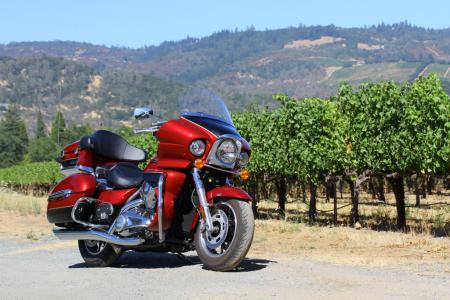 Ridin’ large in California’s Napa Valley. Ridin’ large in California’s Napa Valley. |
So, on a bright summer morning, we loaded up a Voyager for our trip south. This kind of bike is designed to carry two people in comfort, so my wife, Carolyn, came along to test the pillion accommodations. Longtime riders will know that the addition of a female to a trip can tax a bike’s storage capacity, but the Voyager sucked up all we had.
The attractive saddlebags are reasonably large at 38 liters each, but it’s the 50-liter top box that really expands the Voyager’s luggage capacity by inhaling items of nearly any size, including two full-face helmets when not stuffed with clothes and makeup and curling irons. A highly visible LED light-bar spans the rear width of the trunk and augments the V-shaped LED taillight.
The cargo box also incorporates a plush backrest and minimal armrests for a passenger, adding comfort and security. A broad and supportive pillion seat will keep your significant other content during long stints, aided by floorboards that allow a variety of knee bends.
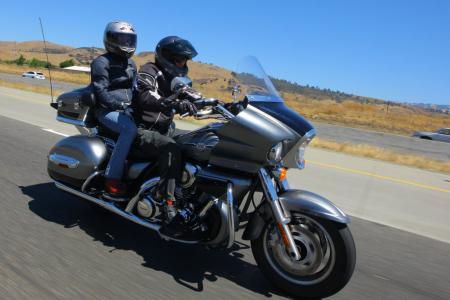 |
The Voyager’s front seat is at least as pleasing. It’s placed at a fairly low 28.7 inches (0.4 inch lower than its H-D rivals) despite being thickly padded, and it delivers a neutral ergonomic triangle with a comfortable bar bend and roomy floorboards that fit riders of all sizes.
Laid out in front of a rider is an eye-catching instrument panel with vintage-look gauges, including a separate tach and speedo in a retro circular design bookended by smaller round gauges for fuel and coolant temp. A central LCD panel displays info about average fuel economy, range to empty, clock and a gear-position indicator. At the bottom of the dashboard is the display for the audio menus that incorporate readouts for iPod docking.
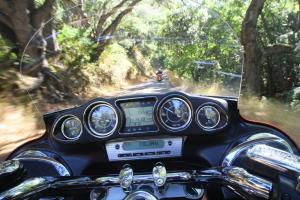 A glovebox on either side of the cockpit provide stowage for small items; the left one can be wired for an MP3 player dock. The right side of the inner fairing is equipped with a 12-volt socket. Our bikes were fitted with a pair of 12V plugs for the passenger’s power requirements.
A glovebox on either side of the cockpit provide stowage for small items; the left one can be wired for an MP3 player dock. The right side of the inner fairing is equipped with a 12-volt socket. Our bikes were fitted with a pair of 12V plugs for the passenger’s power requirements. Approaching the Voyager, there’s no getting around its imposing size. Its nose is distinctive and classy, with a single headlight framed by a pair of standard driving lights. Also classy is our tester’s two-tone paint scheme (a $1000 option on an Electra Glide and unavailable on a Road Glide Ultra) with a sparkling metallic blue over a tasteful silver. The engine is nicely finished with polished and contoured cylinder fins and chrome valve covers, engine guards, primary-drive cover and airbox surround.
Like all big baggers, it requires quite a heft to bring the Voyager off its sidestand; a slightly longer prop would lessen the amount of heave it takes to pull the bike upright. It feels well balanced at a stop.
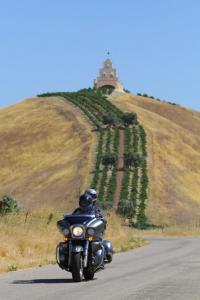 However, the big tourer reveals its heft during low-speed maneuvers. It feels awkward at sub-5-mph speeds, perhaps due to its wide and tall bias-ply 130/90-16 front tire that gives rubbery front-end feedback. That vague front-end feel also makes a rider unsure of which way the bike will lean when coming to a stop. I didn’t require the tip-over protection provided by crash bars at the front and around the saddlebags, but the Voyager caused a couple of tense moments at low speeds. If the bike were mine, I’d be tempted to ditch the Bridgestone Excedras and fit a set of radials with a lower-profile front tire.
However, the big tourer reveals its heft during low-speed maneuvers. It feels awkward at sub-5-mph speeds, perhaps due to its wide and tall bias-ply 130/90-16 front tire that gives rubbery front-end feedback. That vague front-end feel also makes a rider unsure of which way the bike will lean when coming to a stop. I didn’t require the tip-over protection provided by crash bars at the front and around the saddlebags, but the Voyager caused a couple of tense moments at low speeds. If the bike were mine, I’d be tempted to ditch the Bridgestone Excedras and fit a set of radials with a lower-profile front tire. The Voyager’s turn-in behavior is better at higher speeds. It steers quicker than something this big has a right to, making it feel light on its feet for a large girl. Credit a reasonable 30-degree rake angle and a narrowish 170/70-16 rear tire, despite a wheelbase 2 inches longer than a Harley bagger.
When it’s time to gain speed, the Voyager’s 1700cc motor pumps out the kind of grunt expected from a big V-Twin. Although it’s not the class of the field, its 66 hp and 86.3 ft-lb of torque (when measured on a Vulcan 1700) out-muscles the Harley Twin Cam 96 by nearly 10%. Clutch pull is fairly light, and short gearing in the first two cogs make for spritely acceleration from a stop.
The Vulcan engine emits a pleasantly loud, burly sound, both from its intake and its rumbling exhaust. Vibration is nicely subdued by dual counterbalancers in normal use, but a rider can feel big pistons thudding below when it’s opened up and revved out. An overdriven sixth gear is very tall, the Twin loping along at just 2100 rpm when cruising at 60 mph. Best response below 65 mph is from fifth gear, which is also an overdrive ratio. Switching gears is quite smooth for a rig in this class, and its heel/toe shifter allows a simple stomp when quick upshifts are needed.
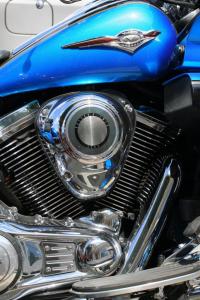 Some 2009 Voyager owners complained of excessive heat coming off the engine in hot weather, so Kawasaki installed a new heat-deflecting shield to route hot air away from the rider. It proves to be marginally effective, but a rider still gets soaked with engine heat when the mercury threatens to hit triple digits.
Some 2009 Voyager owners complained of excessive heat coming off the engine in hot weather, so Kawasaki installed a new heat-deflecting shield to route hot air away from the rider. It proves to be marginally effective, but a rider still gets soaked with engine heat when the mercury threatens to hit triple digits. Over-the-road composure is where the Voyager shines. A beefy 45mm fork does a great job at smoothing out road imperfections, while a pair of air-adjustable shocks with 4-position rebound damping provides stability and comfort.
And while you’re not bothered by bumps in the road (unless leaned over in a corner), you’ll have time to enjoy a powerful stereo system. Unlike the stereos in our recent Bagger Shootout, the Voyager needs only half its volume capability to be heard easily by the rider at highway speeds thanks to a powerful amplifier. However, your passenger won’t enjoy the garbled tones coming from the front speakers, so we recommend the accessory rear speaker kit if he/she is an audiophile. Audio controls reside on the left handlebar, and the iPod-compatible functions can be seen on the display screen.
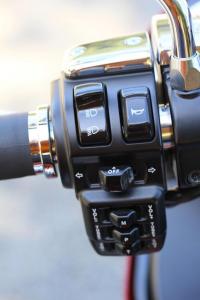 Standard cruise control, with buttons on the right-side switchgear, helps thwart rider discomfort. Self-canceling turnsignals are another nice feature. We also enjoyed the ability to remove the key from the ignition after startup, putting it securely in our pocket until the next ride.
Standard cruise control, with buttons on the right-side switchgear, helps thwart rider discomfort. Self-canceling turnsignals are another nice feature. We also enjoyed the ability to remove the key from the ignition after startup, putting it securely in our pocket until the next ride. Our Voyager was equipped with the safety net that is antilock brakes. It’s an $1100 option that includes 4-piston calipers up front rather than the 2-piston clampers on the other V17s, and the Tokicos offer a firm brake lever. Rear braking is made simple by a large brake pedal that’s easy to stomp on. ABS intrusion is partially mitigated by it automatically disengaging below 4 mph.
But the ABS system has another trick up its sleeve called K-ACT. Pressure sensors at each master cylinder detect the level of braking based on the bike's speed, then uses a motor-driven actuator to vary the amount of pressure applied to the front-right caliper and/or rear caliper as necessary. Its intervention is nearly transparent – aided by the linking effect being disengaged below 12 mph – making it a worthy feature on a touring machine like this.
Aside from the Voyager’s awkward handling at parking-lot-speeds, there’s not much to whine about. Sure, its 5.3-gallon fuel capacity is a bit on the small side, but it’s still good enough for 200-plus miles per tank at its 40 mpg consumption we regularly saw.
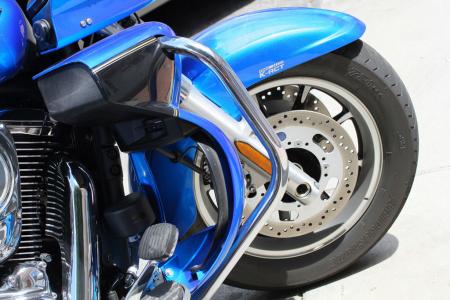 Our Voyager test bike was equipped with optional ABS and K-ACT linked braking. Note the open vents in the leg protection and the tire’s tall sidewall. Our Voyager test bike was equipped with optional ABS and K-ACT linked braking. Note the open vents in the leg protection and the tire’s tall sidewall. |
The Voyager is an appealing package on its own, but it becomes even more attractive when its MSRP is factored in. A 2010 edition retails at $17,299, while an ’11 costs $200 more. You’ll have to pay around $23K for a comparable Road Glide Ultra.
The more powerful Victory Cross Country – overall winner of our Bagger Shootout – looks impressive with its starting price of $18K, but you’ll have to shell out an extra $1749 for its quick-release cargo box, and it’s missing the leg fairings of the Voyager. The direct competitor to the Vic CC is Kawi’s upcoming Vaquero, which Bagger Boy Pete will be reporting on in a couple of weeks. It lists at $16,499.
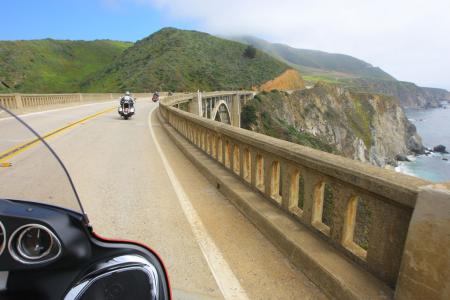 The Kawasaki Voyager proves to be a pleasant place to take in roadside scenery. The Kawasaki Voyager proves to be a pleasant place to take in roadside scenery. |
What’s more, Kawasaki backs the Voyager with a three-year warranty that beats the Harley’s two-year plan and the Vic’s 12 months.
So if the idea of a luxurious V-Twin touring rig appeals to your wanderlust for the open road, Kawasaki’s Voyager delivers the segment’s best bang for the buck.
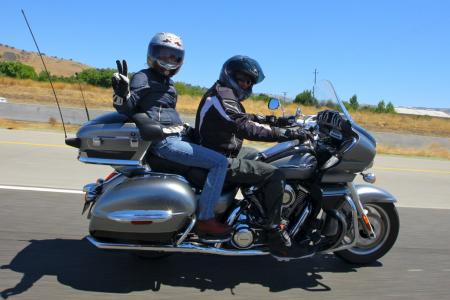 Glad you got to come for a ride with us! Glad you got to come for a ride with us! |



 8:03 AM
8:03 AM
 Unknown
Unknown


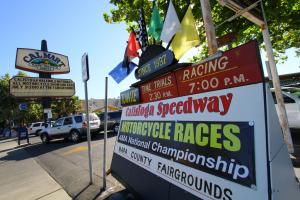
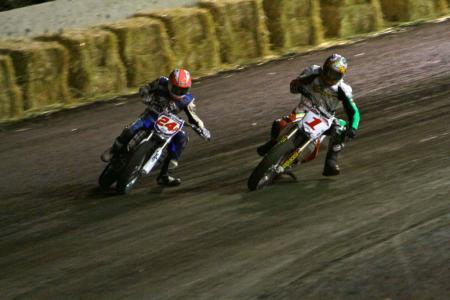 Brad Baker (1) won the Pro Singles class in a thrilling last-corner pass for the lead over Jeffery Carver (24) at Calistoga Speedway. This class consists of converted motocross machines with 450cc engines, but don’t expect them to be slow around a half-mile dirt track.
Brad Baker (1) won the Pro Singles class in a thrilling last-corner pass for the lead over Jeffery Carver (24) at Calistoga Speedway. This class consists of converted motocross machines with 450cc engines, but don’t expect them to be slow around a half-mile dirt track.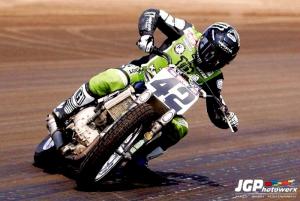
 Posted in:
Posted in: 




0 comments:
Post a Comment